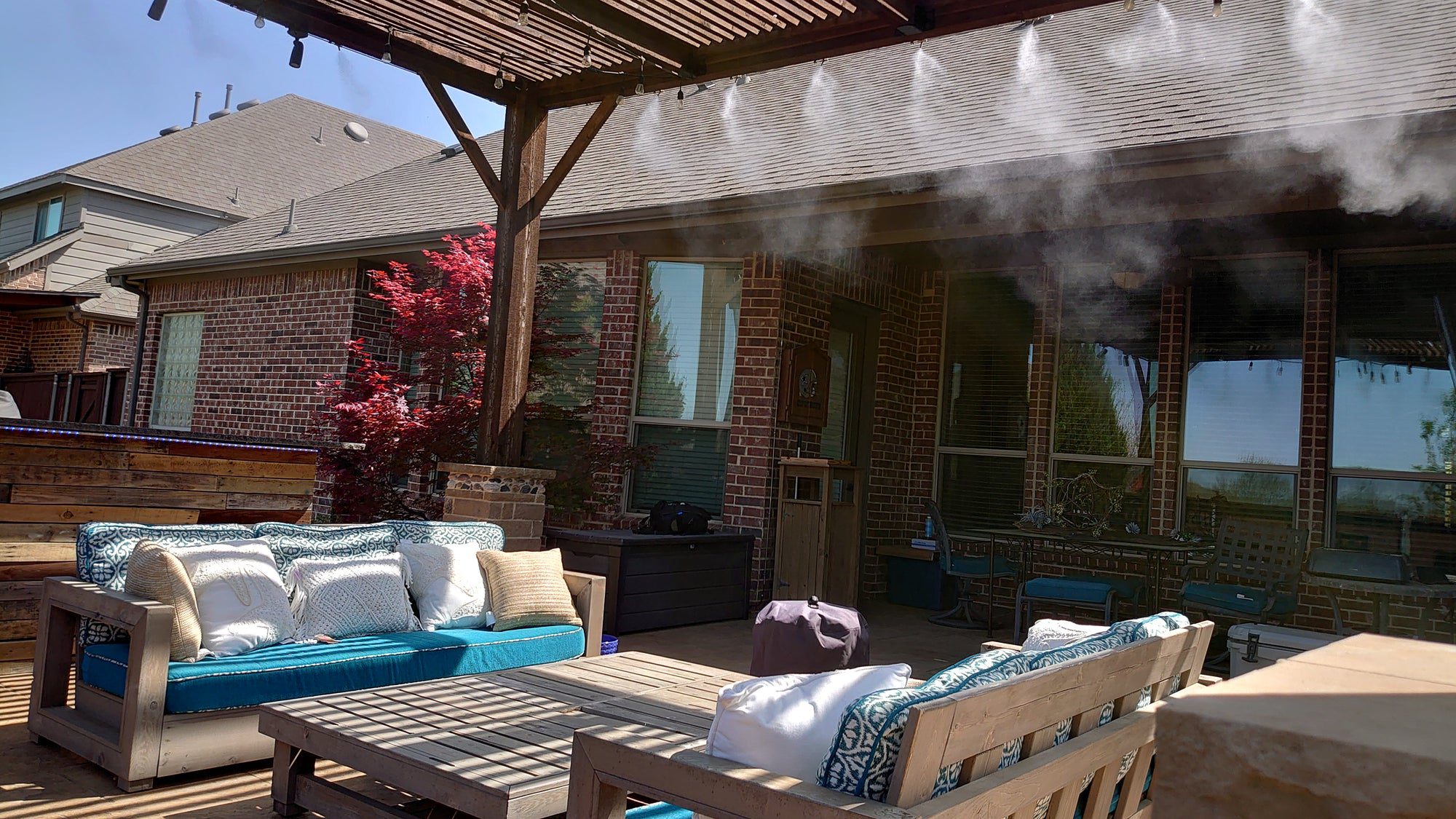A DIY mosquito misting system is a convenient and effective solution to keep mosquitoes at bay. It is easy to install and can provide long-lasting mosquito control in your outdoor spaces.

Credit: pestgnome.com
Understanding Mosquito Misting Systems
If you’re tired of swatting away mosquitoes every time you step outside, it’s time to consider investing in a mosquito misting system. These innovative systems are designed to rid your outdoor space of annoying mosquitoes, allowing you to enjoy mosquito-free evenings in your backyard. In this article, we’ll dive deeper into the world of mosquito misting systems, exploring what they are and how they work.
What Are Mosquito Misting Systems?
Mosquito misting systems are automated devices that release a fine mist of insecticide into your outdoor space. These systems are specifically designed to target and eliminate mosquitoes, reducing their population and creating a more comfortable environment for you and your family. Mosquito misting systems consist of a series of nozzles strategically placed around your property, connected to a central control unit that disperses the insecticide.
How Do Mosquito Misting Systems Work?
Mosquito misting systems work by delivering a precisely measured amount of insecticide into the air to kill mosquitoes on contact. The control unit is programmed to release the mist at specific times of the day or based on a predetermined schedule. When the mist is released, it creates a barrier of protection around your property, effectively killing any mosquitoes in the area.
These systems are equipped with sensors that detect mosquito activity, ensuring that the misting is activated when mosquitoes are most active, such as at dawn and dusk. The insecticide used in mosquito misting systems is generally safe for humans and pets when used as directed, but it’s important to follow the manufacturer’s instructions and take necessary precautions.
Mosquito misting systems offer several benefits, including:
- Efficient mosquito control
- Convenience and automation
- Reduced need for manual mosquito repellents
- Improved outdoor living experience
In conclusion, mosquito misting systems are an effective way to combat mosquitoes and create a mosquito-free outdoor space for you and your family to enjoy. By understanding how these systems work, you can make an informed decision and take the necessary steps to say goodbye to those pesky mosquitoes once and for all.

Credit: www.amazon.com
Benefits Of Using A Diy Mosquito Misting System
Are you tired of swatting away mosquitoes and constantly applying chemical sprays just to enjoy the outdoors? Look no further than a DIY mosquito misting system. Not only does it offer effective mosquito control, but it also saves you money, is easy to install, and reduces your reliance on chemical sprays.
Cost-saving
A DIY mosquito misting system is a cost-effective solution for long-term mosquito control. By installing the system yourself, you can avoid expensive professional installation fees. Additionally, with its efficient usage of insecticides, a DIY mosquito misting system helps minimize product waste, ultimately saving you money.
Easy Installation
Installing a DIY mosquito misting system is a breeze, even for those without any technical expertise. Most systems come with detailed instructions and user-friendly components, making the installation process straightforward. Within a short time, you can have your system up and running, providing mosquito protection for your outdoor space.
Effective Mosquito Control
A DIY mosquito misting system offers powerful mosquito control, ensuring your outdoor area remains bite-free. The system operates by releasing a fine mist of insecticide, targeting mosquitoes and other flying insects. With strategically placed nozzles, it creates a barrier that effectively repels and eliminates mosquitoes, allowing you to enjoy your backyard without the nuisance of biting pests.
Reduced Reliance On Chemical Sprays
Using a DIY mosquito misting system reduces your dependency on chemical sprays, which can be harmful to both the environment and your health. The system disperses the insecticide in controlled amounts, minimizing the need for frequent spraying. By adopting a more targeted and efficient approach, you can decrease your exposure to chemicals while still enjoying bug-free outdoor activities.
Components Needed For A Diy Mosquito Misting System
When it comes to protecting your outdoor space from pesky mosquitoes, a DIY mosquito misting system can be a cost-effective solution. By assembling a few key components, you can create your own system that effectively repels these annoying insects. Here are the essential components you will need:
Misting Unit
A misting unit is the heart of your DIY mosquito misting system. It is responsible for generating a fine mist of insecticide solution and dispersing it throughout your yard. This unit consists of a high-pressure pump, a reservoir for holding insecticide, and a control panel to regulate the misting process.
Nozzles
Nozzles play a crucial role in distributing the insecticide mist evenly. These small devices are attached to the misting unit and emit the fine mist over your desired area. It is important to choose high-quality, clog-resistant nozzles that provide efficient coverage. Strategically placing the nozzles at regular intervals ensures optimal mosquito control.
Piping System
The piping system connects the misting unit to the individual nozzles. It comprises durable, UV-resistant tubing that can withstand outdoor conditions. Properly laid out piping ensures an efficient flow of the insecticide solution from the reservoir to the nozzles. Regular maintenance, such as flushing the system to prevent clogs, is essential for optimal performance.
Control Panel
The control panel is the interface that allows you to program and manage your DIY mosquito misting system. It enables you to set the misting schedule, adjust the misting duration, and monitor the system’s performance. A user-friendly control panel with intuitive controls makes it easy to operate and customize your mosquito control settings.
Insecticide Solution
An effective insecticide solution is a key component of your DIY mosquito misting system. It is formulated to kill and repel mosquitoes when dispersed as a fine mist. To ensure the safety of humans and pets, choose an insecticide that is specifically designed for outdoor mosquito control and follow the manufacturer’s instructions for proper use and concentration.
Credit: www.mrmr.biz
Step-by-step Guide To Building Your Diy Mosquito Misting System
Are you tired of battling pesky mosquitoes every summer? A DIY mosquito misting system can help you reclaim your outdoor space and enjoy mosquito-free evenings. Building your own system may sound daunting, but with this step-by-step guide, you’ll be able to design and install your very own mosquito misting system in no time. Get ready to say goodbye to those annoying bloodsuckers and say hello to outdoor bliss!
Designing The System
Before jumping into the installation process, it’s crucial to design your mosquito misting system. Consider the size of your outdoor space, the layout, and the areas most frequented by mosquitoes. Determine the best location for the misting unit, as well as where the nozzles should be placed for maximum coverage. Planning ahead will ensure an efficient and effective mosquito control system.
Installing The Misting Unit
Once you have the design in place, it’s time to install the misting unit. Choose a location near a power source and mounting surface that can support the weight of the unit. Follow the manufacturer’s instructions for mounting the unit securely. Make sure to position it at a height that allows for easy access during maintenance and refilling the insecticide solution.
Mounting The Nozzles
Mounting the nozzles is a critical step in ensuring proper mosquito control. Place the nozzles strategically around your outdoor area, focusing on areas where mosquitoes are likely to gather. Use mounts or clips to secure the nozzles to walls, fences, or other structures. Position the nozzles facing downward at a 45-degree angle, approximately 8-10 feet apart, for optimal mist coverage.
Setting Up The Piping System
Next, it’s time to set up the piping system that will carry the insecticide solution to the nozzles. Measure the distance from the misting unit to each nozzle and cut the appropriate lengths of PVC pipe. Connect the pipes using fittings, making sure they are secure and leak-free. Use pipe straps to fasten the pipes to walls or other structures, keeping them elevated to avoid accidental damage.
Connecting The Control Panel
Now that the misting unit and piping are in place, it’s time to connect the control panel. Consult the manufacturer’s instructions to ensure the proper wiring connections for your specific system. Make sure the control panel is easily accessible for regular maintenance and adjusting the misting schedule. Follow the wiring diagram provided by the manufacturer to connect the control panel to the misting unit and power source.
Mixing And Adding The Insecticide Solution
The success of your mosquito misting system depends on the right insecticide solution. Follow the manufacturer’s instructions for mixing the solution and adding it to the misting unit. Be cautious and use gloves to protect your skin from any direct contact with the concentrated insecticide. Properly mix and proportion the solution to provide effective mosquito control without harming beneficial insects.
Testing And Adjusting The System
With the system fully set up, it’s time to test and adjust to ensure optimal performance. Turn on the misting system and observe the misting patterns and coverage. Adjust the misting schedule and duration as needed to fit your specific mosquito situation. Regularly inspect the system for any leaks, clogs, or malfunctions and address them promptly to maintain an efficient mosquito misting system.
Frequently Asked Questions On Diy Mosquito Misting System
How Does A Diy Mosquito Misting System Work?
A DIY mosquito misting system works by emitting a fine mist of insecticide through nozzles strategically placed around your property. When the system is activated, the mist covers the area and kills mosquitoes on contact. It provides an effective long-term solution for mosquito control.
What Are The Benefits Of Using A Diy Mosquito Misting System?
Using a DIY mosquito misting system offers several benefits. Firstly, it provides continuous protection against mosquitoes, ensuring a mosquito-free outdoor space. Secondly, it is cost-effective compared to hiring professional mosquito control services. Lastly, a DIY system gives you the convenience and flexibility to control mosquito populations on your own schedule.
Can I Install A Diy Mosquito Misting System Myself?
Yes, you can install a DIY mosquito misting system yourself. These systems usually come with detailed instructions and can be easily set up using basic tools. However, if you’re not comfortable with handling plumbing or electrical work, it’s recommended to hire a professional to ensure proper installation and functionality.
How Effective Is A Diy Mosquito Misting System In Controlling Mosquitoes?
A DIY mosquito misting system is highly effective in controlling mosquitoes. By regularly dispensing insecticide mist, it eliminates adult mosquitoes and disrupts their breeding cycles. With continuous application, it significantly reduces mosquito populations in the treated area, providing an enjoyable outdoor experience for you and your family.
Conclusion
To sum it up, creating a DIY mosquito misting system can provide an effective solution to keep these annoying insects at bay. By following the step-by-step instructions and using the right materials, you can enjoy a mosquito-free outdoor space. Not only will this save you money, but it also allows you to customize the system based on your specific needs.
So, why wait? Start building your own mosquito misting system and reclaim your outdoor comfort today!
- The Power of Mobile Accessibility And Real-Time Tracking for Trucking Operations - November 6, 2024
- Why Ease of Use is Crucial in Trucking Dispatch Software - September 22, 2024
- Better Communication With Dispatchers: How Trucking Dispatch Software Can Optimize Operations - September 7, 2024



